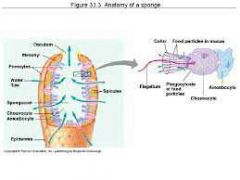![]()
![]()
![]()
Use LEFT and RIGHT arrow keys to navigate between flashcards;
Use UP and DOWN arrow keys to flip the card;
H to show hint;
A reads text to speech;
8 Cards in this Set
- Front
- Back
|
Invertebrates |
animals that lack backbines, they account for 95% of known animals species |
|
|
platyhelminthes |
flat worms, flukes, tapeworms -bilateral symmetry -aocelomate |
|
|
nematoda |
round worms |
|

|
mesophyl- 2 layers of cell making up the wall of the sponge |
|
|
Systems present and not present in platyhelminthes |
Present -muscle system -nervous system -incomplete digestive system NOT PRESENT -Circulatory -Respiratory |
|
|
Class Turbelleria example of species |
flat worms Planaria -move by cilia -have an eyespot -monoecious |
|
|
Class Trematoda |
-Flukes -Parasitic -no cilia -have suckers |
|
|
Class Cestoidea |
Tape Worms -parasitic -have cilia -have suckers and hooks |

